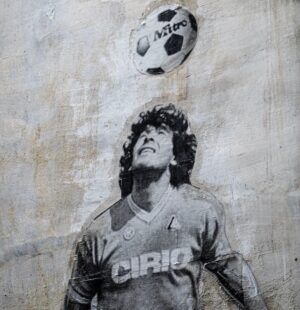Balance, grace, cunning, and determination; Diego Maradona possessed so many stand-out attributes that put him head and shoulders above all who he faced.
His tale is one of fortitude and perfecting a craft that propelled him to incredible heights.
Yes, there was controversy marring some of the more notable aspects of his career and personal life, but he was an enigmatic figure that nobody will ever forget, nor would they want to.
Diego Maradona: A talent like no other
“El Pibe de Oro” (The Golden Boy), as he came to be known, began his career in Buenos Aires, representing Argentinos Juniors at just 15 years of age – an Argentine record. His stellar performance earned him a move to Boca Juniors, a household name in South America.
It was at Boca Juniors where European clubs began to sit up and take notice of this young prodigy. He wasn’t there for an extended amount of time, but scintillated regardless. Barcelona captured Diego’s signature and Maradona flew over to Spain to start the European chapter of his story.
Unfortunately for Maradona, his move to Barcelona didn’t quite play out as many had hoped, due to illness and injuries. His soured relationship with the Catalan club’s hierarchy resulted in the Argentine leaving Barcelona sooner than Diego may have anticipated.
There was one winner as a result of the quarrel between Maradona and Barcelona: SSC Napoli. The Italian club mustn’t have been able to believe their luck that the Golden Boy was becoming a Neapolitan.
Quotas on Italian clubs signing overseas players meant that Napoli was left relatively unchallenged by Serie A counterparts in snapping up Maradona. Their offer was satisfactory and Diego was officially a Napoli player.
Eyebrows were certainly raised when Diego opted for Napoli. For starters, they were near the foot of the Italian top division the season before Maradona signed. Journalists were ejected from his welcoming press conference when asking for Diego’s views on the infamous mafia influence in the city; many people from northern Italy looked down on clubs in the south, but labeling the club as chaotic would be a fair assessment, making his move there all the more surprising.
The greatest goal ever scored
How high in quality must a goal be for opposing fans to regularly vote for it as the greatest goal of all time, especially considering the context of that very player committing one of soccer history’s most infamously calculated deceits?
When Diego collected the ball from deep in Argentina’s 1986 World Cup quarter-final against England, even the most optimistic Argentines couldn’t have predicted what was to come, despite everybody in the Estadio Azteca being acutely aware of his capabilities.
Initially, Maradona’s teammate played the ball into Diego despite having his back to goal and two English midfielders in the vicinity. No trouble, he must’ve thought, as he had the guile and wherewithal to rhythmically dance between his opponents, evading their attempts to disarm the little magician and set him loose with his momentum heading forward.
Having advanced forward a further 20 yards or so, Maradona dropped his shoulder while knocking the ball beyond his next obstacle, leaving him helpless. Diego then cuts past a defender on the edge of the box who might’ve been expecting Maradona to continue his run diagonally; he didn’t have to, Maradona had the requisite close control and balance to alter, almost contort, his body position in full flow that other soccer players could only dream of doing.
Sticking with the inside of his foot, Diego rounds Peter Shilton who, in hindsight, throws his body to the ground the wrong way, making Maradona’s path to a clear goal easier. You can understand Shilton’s resentment towards the Argentine for the Hand of God incident, yet this moment might also add to the bitter feelings the goalkeeper holds towards Maradona.
The net was empty but Maradona encountered a last-ditch attempt to halt him in his tracks from behind just as he was swinging his foot towards the ball. Had the defender arrived a fraction of a second sooner, one of soccer’s most iconic moments would never have happened.
Yet, falling to the ground as his balance was finally giving way no less, Maradona poked home to complete, by some accounts, the best goal the game has ever witnessed. Several moments of pure individual brilliance merged to bamboozle England and send the soccer world into ecstatic overdrive.
Diego Maradona: The Hand of God
For all his talent, Maradona was as divisive as he was majestic. Inspiring and antagonizing at every turn, typified in the very same 1986 World Cup fixture against England. Who knows how advanced Maradona’s thought process was regarding the number of opposition players he’d slalom? He’s often cited as the primary reason Argentina went on the lift the World Cup trophy in Mexico that year, carrying his team through games that they otherwise may have struggled in, sometimes through foul means.
There was no question of his genius, this was plain to see, but there remained an unpredictability that could surface at any moment, inciting an explosive atmosphere wherever he went.
When Maradona ventured on one of his trademark dribbles in England territory, you could sense the threat that was looming. He attempted to lay the ball off to a teammate, but it was a poorly executed clearance from English defender Steve Hodge that sent the ball goalwards.
With just Maradona and goalkeeper Peter Shilton contesting aerially, there was only going to be one winner. However, Diego vaulted as high as his legs would allow and appeared to head beyond the oncoming punch of Shilton to give Argentina the lead. How could a man of such small stature leap higher than a keeper with his arms raised?
It was only until the TV replays were broadcasted that the world discovered that Diego had conned the officials by using his fist to reach the ball before the goalkeeper and punch it into an empty net.
When quizzed on the famous Hand of God incident, Diego was clearly unrepentant, suggesting that England wasn’t so bothered about the integrity of the game after their dubious goal in the 1966 World Cup Final. Maradona’s comments may have been tongue-in-cheek, but they allude to a “win at all costs” mentality, whatever it takes for your country.
The surrounding context of the Falklands War, a military conflict between the UK and Argentina, made this goal all the sweeter for Argentines. Maradona himself stated that the Hand of God goal was a crumb of justice for his compatriots, adding to the legend of his national invincibility.
Spurred on by Diego, Argentina went on to lift the 1986 World Cup and, by all accounts, Diego Maradona was the key reason for this. His crowning achievement which elevated him to soccer immortality.
A home away from home

Spend any time walking around the streets of Naples and you’ll encounter numerous murals depicting the little magician as a deity. While he only stood at 5’5”, residents in his adopted city placed him on a pedestal as tall as Mount Vesuvius.
Clubs globally were yearning for Diego’s signature, he’d have had his pick of elite outfits if he desired, yet remained loyal to Napoli when others might have sought a more guaranteed likelihood of trophies elsewhere. Napoli was not a serious player in Italian soccer; that is until Maradona showed up.
The Napoli shirt he wore during his spell there had ‘Mars’ as its sponsor, and you’d be forgiven for thinking he himself was from another planet, capable of unworldly skills.
His seven-year spell in Naples saw him nearly average a goal every other game. Before Diego, Napoli was an afterthought in Italian soccer, so when the club won its first ever Serie A title with Maradona playing a starring role, the Argentine was virtually given the freedom of the city.
Another league title, a UEFA Cup, and a Coppa Italia would follow, substantiating the calls for Napoli to retire the No.10 shirt, which it duly did.
The club decided to honor his legacy further by renaming their home ground to Stadio Diego Armando Maradona, something reserved for untouchables at clubs, and Diego was certainly that.
D10S
Diego Maradona passed away in November 2020. Argentina collectively mourned their hero. There was an outpouring of love and tributes for a man who’d blessed the sport and inspired millions. The biggest names in soccer, past and present, expressed gratitude for what he did for the game and regaled nostalgic tales of his prowess for younger generations to understand his impact on the sport.
Maradona had his well documented struggles with substance abuse and bouts of ill health, but his impact on the pitch will outlive reports of his personal circumstances. After all, they don’t call you D10S for nothing (wordplay used on ‘Dios’, the Spanish word for ‘God’).
I sometimes grow tired of the debates surrounding who the best player of all time is, mostly because it’s impossible to fairly compare players from different generations. Soccer changes so frequently and there are way too many variables at play. Would Maradona be more or less successful in today’s game instead of the era he played in? We’ll never know.
You can certainly see similarities between Maradona and Lionel Messi’s style of play. Perhaps he was the inspiration for the modern superstar, as he has been for so many others over the years. Messi followed Maradona’s footsteps into Barcelona but insisted he could never emulate Diego’s capabilities, such is the regard he is held in.
Simply put, you can’t talk about soccer unless you include Diego Maradona in the conversation. Although he was ‘El Barrilete Cosmico’ (another one of Maradona’s nicknames which translates into ‘The Cosmic Kite’), he never followed the prevailing winds; he set his own course and would go on to lead the way for so many others to express themselves on a soccer pitch.
Keen to learn more about some of the greatest soccer players in history? Check out our recent opinion pieces on Gascoigne, Zidane, Keane, Makelele, and Beckenbauer to learn more about how soccer should be played!

